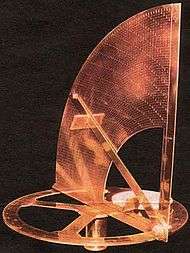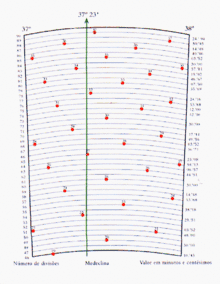Nonius (device)
Nonius is a measuring tool used in navigation and astronomy named in honour of its inventor, Pedro Nunes (Latin: Petrus Nonius),[1] a Portuguese author, mathematician and navigator. The nonius was created in 1542 as a system for taking finer measurements on circular instruments such as the astrolabe. The system was eventually adapted into the Vernier scale in 1631 by the French mathematician Pierre Vernier.[2]

Technical features

The nonius was used to improve the astrolabe's accuracy. This consisted of a number of concentric circles traced on an instrument and dividing each successive one with one fewer divisions than the adjacent outer circle. On a standard scale of 90 degrees, there are an additional 44-45 concentric circles with each divided into a specific unit size such that a scale unit on position had an arc of degrees.[2][3] Thus, the outermost quadrant would comprise 90° in 90 equal divisions, the next inner would have 89 divisions, the next 88 and so on. When an angle was measured, the circle and the division on which the alidade fell was noted. A table was then consulted to provide the exact measure.[4]
Applications
The astronomer Tycho Brahe applied the nonius to the astronomic quadrant.[5][3]
In numerically controlled machines, the nonius is part of several absolute encoders, that measure linear or rotational displacements.[6]
See also
- Transversal (instrument making)
- Nonius connector
References
- "Pedro Nunes". Infopédia [em linha]. Porto: Porto Editora. 2015.
- Poelje, Otto van (25 July 2004). "Diagonals and Transversals: Magnifying the Scale" (PDF). Journal of the Oughtred Society: 22–28. Retrieved 2 May 2017.
- Eisele, Margarete. "Mathematics In Europe - The Nonius". www.maths-in-europe.eu (in Russian). Retrieved 2 May 2017.
- António Estácio dos Reis. "O conceito de nónio" [The concept of Nonius]. Ciência Viva. Archived from the original on 14 April 2015. Retrieved 17 January 2015.
- António Estácio dos Reis. "Tycho Brahe recorre ao nónio de Pedro Nunes" [Tycho Brahe betakes Pedro Nunes' Nonius]. Ciência Viva. Archived from the original on 14 April 2015. Retrieved 17 January 2015.
- "Nonius interpolation provides excellent differential linearity and higher resolution for linear displacement measurement systems or rotary encoders".